‘Art-ma’ has a huge collection of spiritual artworks that include the five classical elements of Hindu mythology. Add them to your cart and integrate them in your life.
Showing all 36 results
-
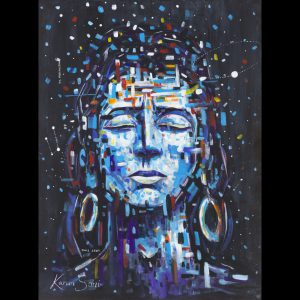
Cosmic Shiva
£ 130.00 – £ 600.00 BUYIntroducing the “Cosmic Shiva”, a painting by talented artist London based Karun Soni, depicting the Hindu god Lord Shiva, using acrylic iterations for a layered approach. The colours are reminiscent of outer space, coupled with warm reds symbolic of a focus mind juxtaposed with an all-knowing, all-seeing perspective.
This piece combines the themes of mental health and the teachings of Lord Shiva. Central to the piece, Shiva is seen to be meditating in order to gain control of his anxious thought. Here He represents the human condition. His teachings focusing on the importance of self-control of the mind, body and spirit in order to lead a successful life.
-
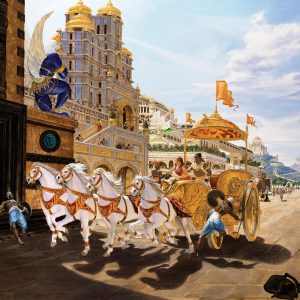
Mahabharata – A Strange Charioteer
£ 180.00 – £ 710.00 BUYThis painting is set within a fabulous landscape, the beautiful town of Dwarka – the kingdom of Lord Krishna. The painting captures the moment lovers flee the town. The excitement of two souls running away in full complicity with one another. But the story is deeper than a runaway chariot driven by a strange charioteer.
A woman named Subhadra, Krishna’s sister, and beside her, Krishna’s best friend Arjuna. Subhadra is promised to another and therefore she planned for Arjuna to kidnap her. They break through the doorway of the city, the guards are pushed aside, as their duty fails short of their destiny.
The artist captured the energy of the moment by depicting the dynamic movement of galloping horses through the city, which is the main focus of this scene.
-
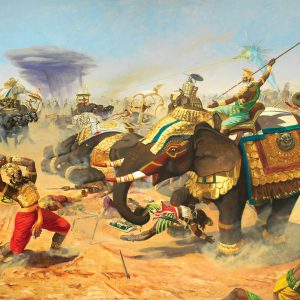
Mahabharata – Bhima and Bhagadatta
£ 145.00 – £ 745.00 BUYBhima is endowed with extraordinary strength and his spectacular feats inspire artistic imagination. He was known for his voracious appetite and in battle he could kill warriors with their elephants only with his mace.
It was possible to trace him on the battlefield simply by following the trail of elephants he had slaughtered. His herculean strength, the fiery character and his total devotion to Lord Krishna and his family led him to perform legendary feats.
The furious and passionate temperament of the great warrior, the bright colours, the red dress, and piercing look of his eyes when fighting – everything speaks about the character of a Kshatriya, always totally committed in defence of society and the moral principles that rule it.
-
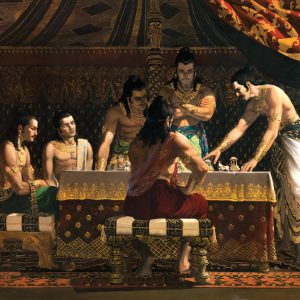
Mahabharata – In the Tent
£ 155.00 – £ 705.00 BUYThe composition and the distribution of the light recall the expressive language of the Italian Baroque period and the atmosphere is inspired by Caravaggio. The dramatic chiaroscuro charges with solemnity the tragic moment that heralds the death of Abhimanyu, the young champion of the Pandava army.
Coloured figurines of soldiers are deployed on the strategic plan, carefully studied by generals. The sharp dark and light enhances the concept that rationality in war has a very relative control over the outcome of the war, other qualities like wrath, courage, strength, resistance and hate contribute strongly to the fulfilment of the destiny. A dramatic sense of the game between karma – destiny – and free will permeate the scene.
-
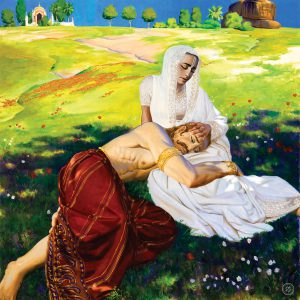
Mahabharata – Karna and Kunti
£ 155.00 – £ 635.00 BUYThis is one of the most moving scenes in the Mahabharata, the moment when Mother Kunti reveals to Karna that he is her first son and therefore the eldest of the Pandava brothers.
Karna is the secret son of Kunti Devi and Surya, the Sun God. On the banks of the Yamuna River, Kunti reveals to Karna the truth about the intimate kinship between them. Their encounter is one of the most poignant moments in the Mahabharata epic, so many sentiments involved in this scene, only piety collecting them all.
-
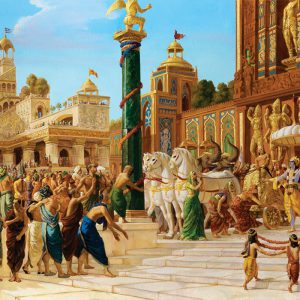
Mahabharata – Krishna entering Dwarka
£ 145.00 – £ 580.00 BUYAfter His travelling around Bharata Varsa Lord Krishna was routinely coming back to his Kingdom of Dwarka. This painting is a tribute of love to Him manifested in the faces and actions of his citizens. Krishna is named also known as Bhagavan, the One that has all transcendental qualities like beauty, power, strength, wealth, fame and compassion.
Here the return of Lord Krishna aroused enthusiasm and joy in the whole city. You can see that all social classes of the Varna-Ashram Dharma are present on the scene, and despite the differences everyone was present. Everyone showing their love and admiration to their Lord. This is to testify the all including society of that time. The three-quarter composition gives the scene a very wide, almost stereoscopic view.
-
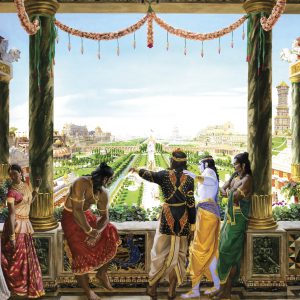
Mahabharata – Krishna in Indraprastha
£ 160.00 – £ 705.00 BUYBefore Indraprastha became the capital of the Pandava’s kingdom, it was the ancient capital of the Kuru clan of which the Pandavas and Kauravas are a part.
At one point in the epic, the Kurus gave the Pandavas a piece of desert land. It had been abandoned for many years and did not look like a place fit to become a capital city. But the Pandavas with the help of Krishna, hard work, determination and skill transformed this wasteland into a beautiful city that would compete with the beauty of Hastinapura, the capital of the empire.
Krishna called upon the heavenly architects Vishvakarma and Mayadhanava, the top designers during that time to transform it into a city fit for the Pandavas. As you can see in the artwork, the architectural accuracy and sophistication made Indraprastha a unique utopia and the perfect example of how cities should be built. Here we can see, in the foreground Maharaj Yudhishthira showing Lord Krishna the great view from the royal palace, as to let us take part in their glance.
-
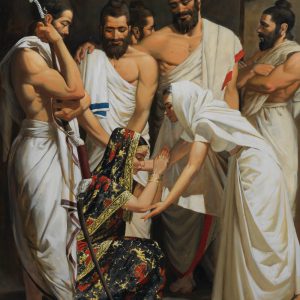
Mahabharata – Kunti and Draupadi
£ 160.00 – £ 795.00 BUYAn intimate simplicity characterises the meeting between Mother Kunti and Draupadi. The painting is devoid of any decorative superfluity. Light is the protagonist of this painting. Taking vantage of the plot in which the Pandavas and their Mother Kunti are in disguise as Brahmanas. They were dressed simply and in white. The white drapery dominates all the lighting, framing the rich black regal sari of Princess Draupadi.
Although Maharaja Draupada’s daughter was elegantly dressed she submits herself to the role of respecting her future mother in law. She was promised to be the wife of the five Pandava brothers, but first she needed to be accepted by their mother!
-
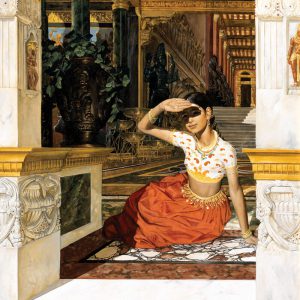
Mahabharata – Kunti and Surya
£ 150.00 – £ 650.00 BUYOne of the most nuanced and inspiring characters in the Mahabharata would be that of Kunti. Her story arc has several layers and her complex childhood and her yearning to be loved all have a purpose.
The secret meeting of Surya, the sun god, depicted in this artwork, with the young Kunti that led to the birth of Karna displays her naivety. The social and psychological barriers make it impossible to reveal her surreptitious pregnancy. A young mother forced to conceal her new born baby by placing him in a basket and entrusting him to the waters of the Yamuna River.
The sunlight is absolutely protagonist in the painting and highlights the predominant narrative and artistic element.
-
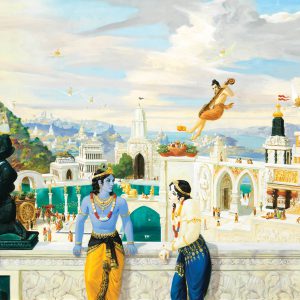
Mahabharata – My Dwarka
£ 155.00 – £ 795.00 BUYCities are a reflection of the ones who built them. The prosperous city of Dwarka, which was capital of Lord Krishna’s kingdom, was a gateway to heaven. Located in modern day Gujarat, the city of Dwarka is often compared to the city of Atlantis, maybe because they both suffered the same fate of being plunged into the depths of the sea.
This painting represents a moment in the daily life of Dwarka. It was described as a vast area in which architecture, palaces and houses are fully merged in the natural landscape of the west coast of India. You can see Krishna and Balarama in a relaxed conversation, framed by marble and bronze. The sky is painted with lightful strokes creating a wide space for legendary figures and flying creatures that break through a banal perception.
-
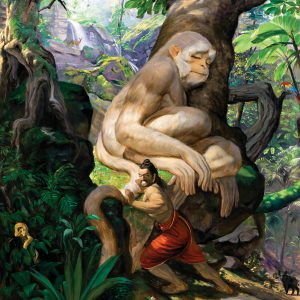
Mahabharata – O Brother – Bhima and Hanuman
£ 155.00 – £ 780.00 BUYThis is the moment when the two most important epic tales of India entwine. The elder brother Hanuman – the divine monkey, meets the younger Bhima in a singular pastime with a final explosion of affection! Hanuman is Bhima’s half-brother, son of Vayu. He is a great warrior and the very embodiment of devotion to Rama, an incarnation of Krishna.
The wild forest is the timeless context of a scene that sees the aged Hanuman meeting his strong brother Bhima. The artist wanted to play with the unusual proportions of the characters as Bhima describes the creature to be ”the biggest monkey he ever saw.”. You can see by contrast, the endeavour that Bhima is making to move Hanuman’s tail and the lazy tired face of the gigantic monkey almost indifferent to this action. There is for sure a link between the intricate elements of the forest and the intrigue of the whole Mahabharata.
-
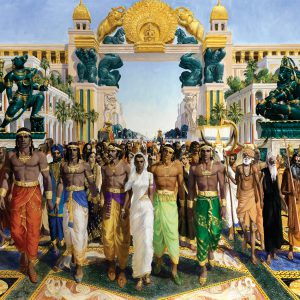
Mahabharata – Pandavas enter Hastinapura
£ 165.00 – £ 660.00 BUYIn this artwork. the Pandava brothers come to Hastinapur after the death of their father, much to the chagrin of Duryodhana. Out of the curiosity and love, all the citizens gather. When the five brothers, enter the city triumphantly with their mother Kunti Devi, accompanied by rishis and great sages.
The composition of this painting shows the frontal view of the crowds that have gathered to greet them and symbolises the entrance of the noble characters into the epic tale, emphasising their presence into the city as well as into the plot of the Mahabharata.
-
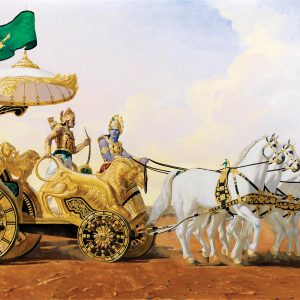
Mahabharata – Parthasarathi
£ 155.00 – £ 755.00 BUYThis is the very heart of Mahabharata, this is the moment that decides how the game will be played. This is the very moment upon which the entire Mahabharata has been written.
The majestic chariot enters the battlefield of Kurukshetra, where the armies are lined up, ready to clash. In these circumstances, Krishna reveals to his friend and devotee Arjuna the secret of Vedic knowledge. The fundamentals of wisdom are conveyed, as he speaks of truth and deception, illusion and reality, virtue, passion and ignorance. The deeper aspects of the psyche, the transcendental nature of the self, the relationship with the Godhead and with other living beings, all come to light very clearly in this dialogue whispered in front of the two armies, and recorded in the Bhagavad Gita (the song of God), one of the primary texts of mankind’s spiritual history.
-
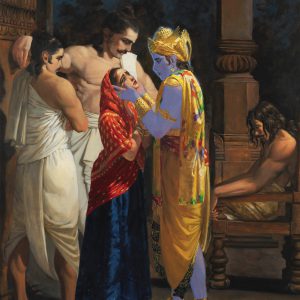
Mahabharata – Save my Honour
£ 160.00 – £ 770.00 BUYOf all the events in the Pandava’s lives, this must be one of the lowest.
Right after having lost the Kingdom and Draupadi’s dignity at the dice contest the Pandavas went into exile in the forest. Krishna saved her honour, by performing a miracle. He provided her unlimited fabric of her sari to prevent her from being disrobed in public.
The nocturnal setting and the light cutting through the darkness, in this moving artwork, contributes to enhance the drama. Krishna consoles Draupadi promising her that everything will be remedied. The desperate face of the woman right in front of the self-effulgent blue God. King Yudhishthira on the right side is the most afflicted, feeling guilty for the big defeat. The painting is in continuity with the “Pandavas were cheated” artwork.
This is the moment when the idea of war mounts seriously although they continued for another 13 year in exile.
-
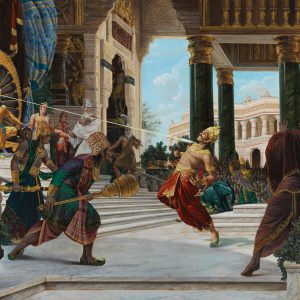
Mahabharata – Shishupala insulting Krishna
£ 160.00 – £ 775.00 BUYThe great proprietary sacrifices were celebrated in rich pavilions specially built by the great architects. The show of opulence was part of the ritual, offered in gratitude to the Lord, to acknowledge His supremacy and invoke protection and prosperity for every citizen. Maharaja Yudhisthira asked Lord Krishna to preside the great Ashwamedha Yajna (the ancient Horse Sacrifice).
The painting depicts the liberation of Shishupala, a powerful and cruel character. You can distinguish the main character of the epic event such as Yudhishthira on Krishna’s left with imperial garments, in the foreground Arjuna with his bow and Bhima with the mace. Right behind them are the two great sages – Bhishmadeva, the great grandfather of the Mahabharata; and the ancient Parashurama, the mystic presence of another Vishnu avatar coming from another era.
-
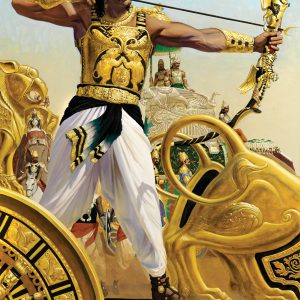
Mahabharata – Shoot him Now – Arjuna
£ 150.00 – £ 695.00 BUYArjuna, son of Indra – the King of the Gods, was the celebrated hero of the Mahabharata. He was a demi-God and possessed admirable virtues such as courage, wisdom, a strong belief in duty and right action.
Here, he is portrayed in the act of shooting a deadly arrow with his divine Gandiva bow, a weapon that terrified the enemy by just looking at. The contrasts between the black and white tones – two extreme points on the light spectrum, enhance the splendour of gold ornaments and emphasise the powerful figure of the great hero.
-
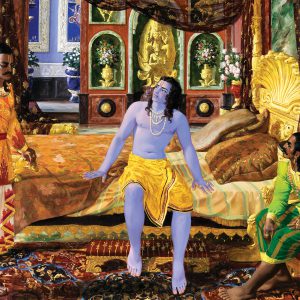
Mahabharata – The Choice
£ 160.00 – £ 790.00 BUYIt is the eve of the great battle of Kurukshetra, when the whole Mahabharata epic is about to be resolved. Sitting on His bed, Krishna announces that He is not going to side with either opponent. He leaves them the choice as to whether to incorporate his powerful personal army into their ranks, or to have Him alone, unarmed and in a secondary role.
Duryodhana, chief of the Kurus, has no hesitation in picking Krishna’s army, where as the Panadavas only desire was to have their dear friend Govinda, Krishna on their side. They are fully convinced that His mere presence on their side will ensure them final victory.
So it is, that Krishna accepts the humble role of driver of Arjuna’s chariot, and thus comes to be known as Parthasarathi.
-
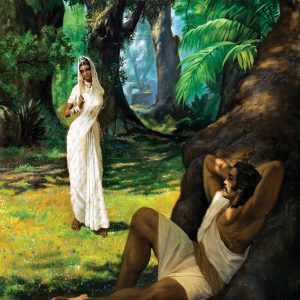
Mahabharata – The Demoness Hidimbi
£ 155.00 – £ 770.00 BUYThis artwork depicts Bhima and Hidimbi’s first meeting. A gorgeous forest becomes the right place for a romantic wild meeting of love, a bucolic scene of seduction with a hint of discreet sensuality.
Hidimbi belonged to the Rakshasa race, giant cannibals with supernatural powers who lived deep in the forests. Despite the major differences between them, their marriage is a short but happy one. Their union generated a much loved son, Ghatotkacha, who was very powerful, humble and loyal.
In the midst of such a dramatic epic, these few tender moments make for a welcome distraction from the pain of troublesome events.
-
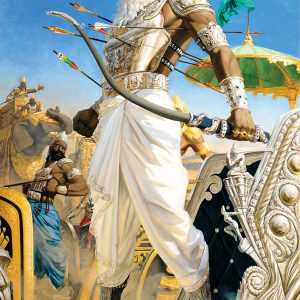
Mahabharata – The Fall of the Hero – Bhishma
£ 220.00 – £ 700.00 BUYThe character of Bhishma in the Mahabharata is the embodiment of the word dharma (duty). His sense of duty and loyalty never wavered.
Bhishma, the great patriarch of the dynasty, was the son to goddess Ganga and always wore silver armour. This artwork depicts the crucial moment on the bloody battlefield, where he is pierced by arrows shot by Arjuna. The painting portrays him moments before his fall, unabashed in his proud and heroic posture. The blue sky serves as a frame to the splendour of the chariot and the armour. This is the prelude to the departure of the noble Bhishmadeva who will be deeply mourned by both sides.
-
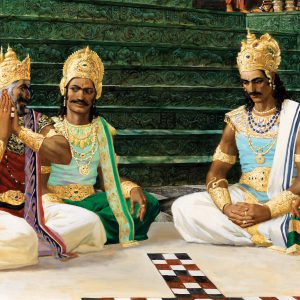
Mahabharata – The Pandavas were cheated
£ 155.00 – £ 770.00 BUYAt the bottom of the steps to the throne, in the middle of the royal room, a tremendous contest happened: it decided the destiny of the Pandava brothers and triggered the tragic event of the Kurukshetra war. The Pandavas are defrauded of royal rights and all belongings by their closest relatives with a rigged game of dice.
Regal dresses hide evil and dishonest personalities. The artist showed mischievous and sinister expressions on the faces of the devious uncle, Shakuni – an expert in the game of dice, and Duryodhana. He wanted to show, expressively, the two very opposing moods of the moment. Arjuna’s resignation, as he knows they are about to lose the contest, and King Yudhishthira’s display of anxiety, for the last throw in the game, where he knows he will lose everything.
-
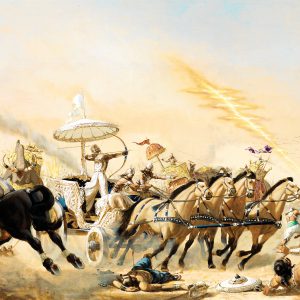
Mahabharata – The Rush of the Hero
£ 165.00 – £ 755.00 BUYBhismadeva, also called Pitamaha – the patriarch, is an oxymoron between old age and his surprising agility and superhuman strength. Fate and code of honour had decided that he was to stand against the Pandavas. Even as he was fighting them in his heart he was on their side.
-
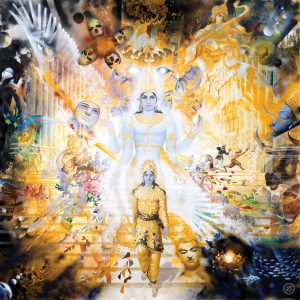
Mahabharata – The Universal Form – Vishva Rupa
£ 165.00 – £ 640.00 BUYIn two moments of the Mahabharata Lord Krishna showed the Vishva Rupa revealing his Divine Nature as Vishnu, the Supreme God. In this painting the artist tries to elaborate His first performance of the so called Universal Form. It is a complex vision explained in an entire chapter of the Bhagavad Gita. The Supreme Being expands in infinite dimensions and entities. The immensity of the universe and the complexity of its constituents are impossible to understand in full. The resulting unusual perception is a network of chaotic and apocalyptic elements, viewed from multiple angels and unusual perspectives as Lord Krishna manifests His Universal Form for the first time.
-
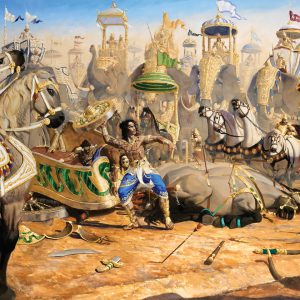
Mahabharata – The Young Hero
£ 150.00 – £ 665.00 BUYThe intense and poignant moment of the death of Abhimanyu. Enemies strongly desired his death and they killed him by deception and betrayal. Surrounded and pierced by innumerable arrows, Abhimanyu stoically fights to his last breath. The young hero’s expected and untimely death enhances his valiant glory.
The artist deliberately seeks to capture the adolescent prowess of the invincible Abhimanyu. Although the body is well shaped and toned, the proportions of the head are slightly larger compared to the body, not unlike the sculpture of David by Michelangelo, thus reflecting the typical physique of a young man not yet in his twenties.
-
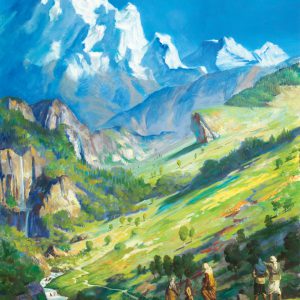
Mahabharata – Towards Badrika Ashram
£ 160.00 – £ 785.00 BUYBrotherhood and love were such that all the brothers and divine Mother Kunti walked a very long trip to the Himalayan mountains to reach a sacred site called Badrika Ashram. Their brother Arjuna was waiting for them there, after so many adventures that lead him even as far as heavenly planets to meet his father Lord Indra – the King of the Gods. He also received boons, such as the legendary bowl that you can see in detail in another painting.
The landscaping, the heavenly and gorgeous view, the small characters, enhance the mystery of the invisible and the spirit of adventurous life.
-
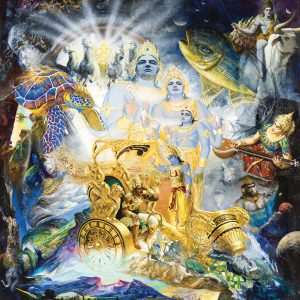
Mahabharata – Virat Roop
£ 1,200.00 BUYThis is the second time Krishna manifests the Virat Roop, but it is at the most important time in the Mahabharata. The Speech of the Bhagavad Gita, is the moment Krishna comes out from the role of Arjuna’s best friend and reveals Himself as the Supreme God Vishnu with all this expansions and that the circumstances of the war was pure illusion, Maya. Arjuna learned that his grief was useless, it was useless to lament. ”Just accept your duty and fight!”.
When Lord Krishna manifests His Universal Form, the world is no longer the same place, the dimensional planes are confused and one becomes lost in amazement. The secure perimeter of the frame contains and holds back the inconceivable universal form, soothing our fears and leaving us in awe.
-
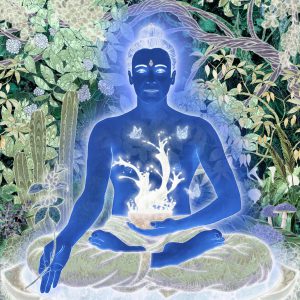
Medicine Buddha
£ 135.00 – £ 900.00 BUYIn this painting you see, Italian artist Parama Libralesso depicts Medicine Buddha, also known as Bhaisayaguru, as a symbol of the healing process. It is that force that guide us in the awakening of the innate healing wisdom that is present in every individual. His meditative pose reminds us that we should look inwards to answer all the questions we ask.
On a white lotus, inlaid with the sheet of the moon, the Buddha of Medicine sits.
His healing body, a dark, transparent blue, is in a state of thorough transformation. In his right hand he holds the plant of Haritaki in the “welcoming gesture” (varadamudrā), and in the left the healing nectar for all, mind, body and soul diseases.
The butterflies symbolise the process, from voracious caterpillar to fluttering creatures able to elect the best nourishment, the pollen. His irises are gold, his gaze looking beyond any illusory veil and judgement, healing all ailment. He is surrounded by the sacred plants of shamanic traditions, as incarnations of healing aspects of nature.
The Medicine Buddha is here to heal all ailments regardless of their nature, this is the perfect time to bring Him into your home.
-
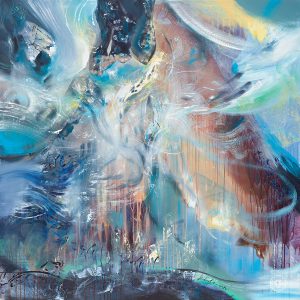
Spirit Element: Air
£ 95.00 – £ 990.00 BUYAir belongs to a series of 5 paintings in art-ma’s collection, each relating to one of the classical elements: Fire, Water, Earth, Air and Space. This collection created by Ovidiu Kloska, is a compilation of abstract paintings, featuring heavy textures in rich colours, resulting in contemporary artwork that is both fascinating and dramatic.
Air is a symbol of our soul, divinity, breath and strength and consciousness. Although the elements are significant across many cultures, in the Upanishad, an ancient scripture from Hinduism, it refers to the elements being used for spiritual growth.
“From Atman (your inner self) did space come into being;
from space, air; from air, fire;
from fire, the waters; from the waters, the earth;
from the earth, plants; from plants, food;
and from food, man…”
– Taittirīya UpaniṣhadIn this painting the big brush strokes of Acrylic in shades of blue, brown, yellow and green sweep across the canvas like the wind, creating a beautiful piece of artwork in Kloska’s series of the five elements.
Artist: Ovidiu Kloska, Original Media: Acrylic on Canvas
-
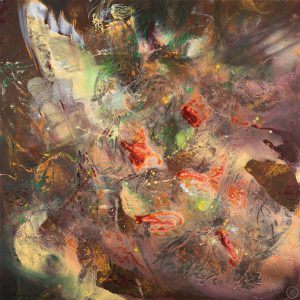
Spirit Element: Earth
£ 95.00 – £ 990.00 BUYEarth belongs to a series of 5 paintings in art-ma’s collection, each relating to one of the classical elements: Fire, Water, Earth, Air and Space. This collection created by Ovidiu Kloska, is a compilation of abstract paintings, featuring heavy textures in rich colours, resulting in contemporary artwork that is both fascinating and dramatic.
The Earth element resembles practical and physically active energy, and is the most stable and persistent of all five elements. It represents groundedness, stability, potential and stillness. It reminds us to let the strength of the Earth ground us in our practice and as we move through life. Although the elements are significant across many cultures, in the Upanishad, an ancient scripture from Hinduism, it refers to the elements being used for spiritual growth.
“The Earth lives within us, not outside of us. The trees are our lungs, the rivers our bloodstream. We are all interconnected, and what you do to the Earth, ultimately you are doing to yourself.”
In this painting the big brush strokes of Acrylic in shades of brown, green and orange earthy tones sweep across the canvas, creating a beautiful piece of artwork in Kloska’s series of the five elements.
Artist: Ovidiu Kloska, Original Media: Acrylic on Canvas
-
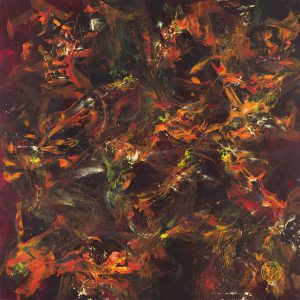
Spirit Element: Fire
£ 95.00 – £ 990.00 BUYFire belongs to a series of 5 paintings in art-ma’s collection, each relating to one of the classical elements: Fire, Water, Earth, Air and Space. This collection created by Ovidiu Kloska, is a compilation of abstract paintings, featuring heavy textures in rich colours, resulting in contemporary artwork that is both fascinating and dramatic.
Fire is a symbol of cleansing and purification. Although the elements are significant across many cultures, in the Upanishad, an ancient scripture from Hinduism, it refers to the elements being used for spiritual growth.
“From Atman (your inner self) did space come into being;
from space, air; from air, fire;
from fire, the waters; from the waters, the earth;
from the earth, plants; from plants, food;
and from food, man…”
– Taittirīya UpaniṣhadIn this painting the bright bold colours of red, orange and yellow, with the big brush strokes of Acrylic on canvas, create a beautiful piece of artwork in Kloska’s series of the five elements.
Artist: Ovidiu Kloska, Original Media: Acrylic on Canvas
-
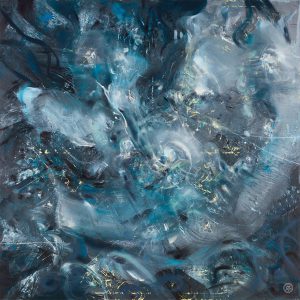
Spirit Element: Space
£ 95.00 – £ 990.00 BUYSpace belongs to a series of 5 paintings in art-ma’s Elements collection, each relating to one of the classical elements: Fire, Water, Earth, Air and Space. This collection created by Ovidiu Kloska, is a compilation of abstract paintings, featuring heavy textures in rich colours, resulting in contemporary artwork that is both fascinating and dramatic.
The Space element is the subtlest of all the elements. It can not be identified by our senses. It can only be felt by our soul. Although the elements are significant across many cultures, in the Upanishad, an ancient scripture from Hinduism, it refers to the elements being used for spiritual growth.
“From Atman (your inner self) did space come into being;
from space, air; from air, fire;
from fire, the waters; from the waters, the earth;
from the earth, plants; from plants, food;
and from food, man…”
– Taittirīya UpaniṣhadIn this painting the big brush strokes of Acrylic in shades of inky dark blue and chalky white sweep across the canvas, creating a beautiful piece of artwork in Kloska’s series of the five elements.
Artist: Ovidiu Kloska, Original Media: Acrylic on Canvas
-
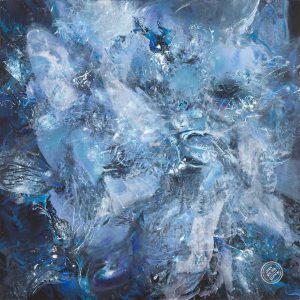
Spirit Element: Water
£ 95.00 – £ 990.00 BUYWater belongs to a series of 5 paintings in art-ma’s collection, each relating to one of the classical elements: Fire, Water, Earth, Air and Space. This collection created by Ovidiu Kloska, is a compilation of abstract paintings, featuring heavy textures in rich colours, resulting in contemporary artwork that is both fascinating and dramatic.
Water is a symbol of purity, fertility, life, motion, renewal, and transformation. Although the elements are significant across many cultures, in the Upanishad, an ancient scripture from Hinduism, it refers to the elements being used for spiritual growth.
“From Atman (your inner self) did space come into being;
from space, air; from air, fire;
from fire, the waters; from the waters, the earth;
from the earth, plants; from plants, food;
and from food, man…”
– Taittirīya UpaniṣhadIn this painting the bright bold colours of different shades of light and dark blue and white, with the big brush strokes of Acrylic on canvas, create a beautiful piece of artwork in Kloska’s series of the five elements.
Artist: Ovidiu Kloska, Original Media: Acrylic on Canvas
-
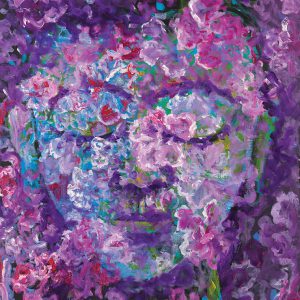
Spring Buddha – Cherry Blossom
£ 125.00 – £ 560.00 BUYThis piece, the second in a collection of 4 representing the four seasons of Buddha, pushes the boundaries of natures’ potential further, to the point at which Buddha is immersed so much in nature, both are evenly depicted in the composition. Buddha has a length of time completely alone with nature, which makes him at peace, and a part of his surroundings.
The Spring Buddha – Cherry Blossom artwork is a melange of shades of purple, pink and blue painted on the canvas, depicting the colours of the season. Subtly in the background you can see Buddha, eyes closed, in his meditative state. This piece conveys serenity and spirituality, and being at one with your surroundings.
Artist: Karun Soni, Original Media: Oil on canvas
-
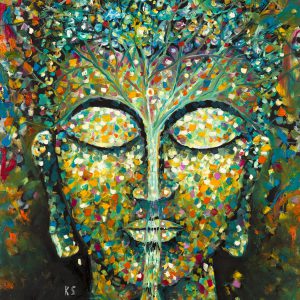
Summer Buddha – At Peace
£ 125.00 – £ 600.00 BUYInspired by the story of Buddha finding enlightenment whilst meditating underneath a tree without moving for seven weeks. This piece, the third in a collection of 4 representing the four seasons of Buddha, pushes the boundaries of natures’ potential further, to the point at which Buddha is immersed so much in nature, both are evenly depicted in the composition. Buddha has a length of time completely alone with nature, which makes him at peace, and a part of his surroundings.
Buddha has become one with the tree and is at peace. This painting also plays on similarities between our anatomy and nature surrounding us. The Buddha sits still and peacefully just like the tree, firmly rooted on the ground.
-
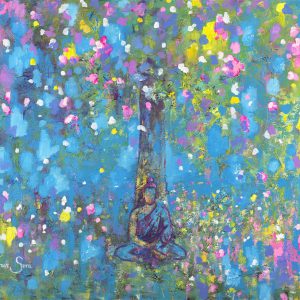
Timeless Buddha
£ 125.00 – £ 600.00 BUYThis piece is based on the famous story of Buddha finding enlightenment underneath a tree. This is part of a series of paintings completed for art-ma by Karun Soni, with both close ups and wider portrayals of the same scene- across various seasons.
He painted this after practicing meditation and learning more about the science behind spirituality, with many principles of original Buddhist meditation benefits still holding up in today’s studies of neuroplastocity and mindfulness.
The biggest part of this is losing the sense of “self” and observing all humans and everything around us as one- which is depicted in each piece of the series through maintaining the same colour palette for Buddha and the nature around him.
-
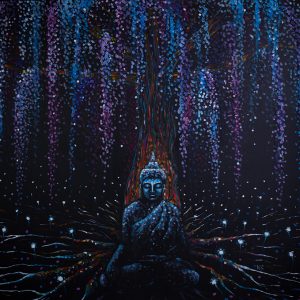
Winter Buddha – Absorbing Energy
£ 90.00 – £ 550.00 BUYInspired by the story of Buddha finding enlightenment whilst meditating underneath the Bodhi tree without moving for seven weeks.
This piece, one of a collection of 4 representing the four seasons of Buddha, pushes the boundaries of natures’ potential further. At night we see that the plants and weeping willow provide natural light and a source of energy for Buddha. This piece conveys serenity and spirituality, and being at one with your surroundings. With a similar colour scheme throughout, the Buddha and the tree become ‘one’ during his quest for inner peace.
Artist: Karun Soni, Original Media: Oil on canvas
-
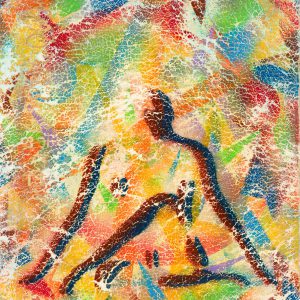
Yoga Multicoloured
Yoga is a practice of physical, mental and spiritual discipline, which represents the mind, body and soul. This unique artwork is called the Yoga Multicoloured, it’s composition symbolises peace. In the centre of the artwork there is a silhouette of a person in “asana” – the Sanksrit word for yogic posture or movement.
The use of the colour in this artwork is uplifting, it reminds you of a rainbow and in turn reminds you of contemplation in the meditative state. In this painting of the Yoga Multicoloured, the artist has adopted a contemporary style to portray Inner Peace.
Artist: Patrizio Landolfi, Original Media: Mixed technique on canvas
